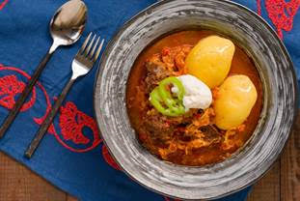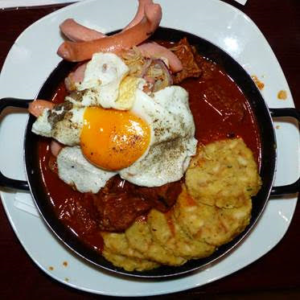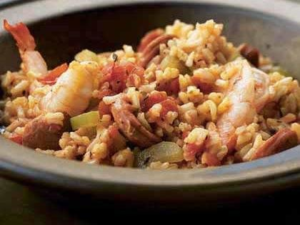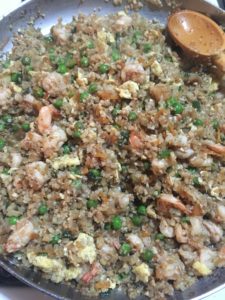Traditional Hungarian Gulyάs

Deriving from the Hungarian word “gulyάs” which means herdsman, Goulash originated in medieval Hungary and is a popular meal eaten in Central Europe and various other parts of the world. Goulash origins trace back to the 9th century and was dried, seasoned and stored in the lining of sheep stomach, not needing much more than water to complete. At that time animal meat was scare and all of the animal was consumed, given this it is understood how the recipe for Goulash is fluid and interchangeable in the preparation for this soup. Overtime gulyάs came to be known as gulyάshύs, which means the “the meat dish prepared by herdsmen.” Gulyάs can vary from being a soup or a stew, many ingredients included in today’s version of Goulash were unknown to the original recipe; such as tomatoes which did not get incorporated into the European food culture until the twentieth century. This thick Hungarian stew did not thicken from flour or roux, rather the heartiness comes from the collagen of the tough muscles of the animals cooked in the dish and reduces to a gelatin while cooking. Typically, Goulash is prepared with beef, veal, pork or lamb- but discussion on variation will commence later. Traditional Hungarian Gulyάs starts with meat of choice chopped into chunks, seasoned with salt and paprika and sautéed with sliced onion in lard or oil. Water or stock is then mixed in and covered and simmered. Other variations include chili pepper, thyme, garlic, caraway seed, bell pepper, potatoes and other soup vegetables (celery, carrots and parsley roots). At times potatoes can be substituted for small egg noodles called csipetke, which are small pinched portions of dough that are dropped into the boiling soup.

Because Goulash is a dish made from limited resources of meat, there are several variations of the Hungarian recipe with the original soup base. Gullies à la Székely is one goulash variation which adds sauerkraut and sour cream minimizing the amount of potatoes used. Mock Gulyάs, which is also called Hamusgulyάs or “fake Goulash,” substitutes the meat for beef bones and adds vegetables. Bean Gulyάs recipes replaces potatoes and caraway seeds with kidney beans. Csάngó Gulyάs substitutes pasta and potatoes for sauerkraut. Betyάr Gulyάs is prepared with smoked beef or pork. Likócsi Pork Gulyάs is prepared with pork and vermicelli in place of potatoes or pastas and flavored with lemon juice. Mutton Gulyάs (also known as Birkagulyάs) is made with mutton which is sheep meat and simmered in red wine. Székely Gulyάs is a richer and thicker Goulash consisting of three different meats and having been named after József Székely- Hungarian writer, journalist and archivist. Kartoffelgulasch (also known as potato Goulash) is a popular and inexpensive peasant stew in German speaking countries.

Thick stews resembling Goulash are popular amongst the former Austrian-Hungarian Empire, from Northeast Italy to the Carpathians. Ingredients, flavors, pairings and presentation varies from nation to nation. In Vienna which is formerly the center of the Austin-Hungarian Empire, a special kind of Goulash is presented- the Wiener Saftgulash which does not include tomatoes or any other vegetables besides onions. Instead of including potatoes or pasta, Wiener Saftgulash is served with only dark bread. A popular variation Wiener Saftgulash is the Fiakergulasch which adds fried egg, fried sausage and dumplings. In Croatia, Goulash is also known as gulaš and is served in many different forms. For starters there are various beef substitutions- boar, deer, Lika and Gorski Kotar to name a few, oftentimes more than one meat is featured and bacon- bacon is a very necessary ingredient in Gulas! Recipe variations are interchangeable between fuži (a Croatian strip pasta), njoki (a dumpling like Gnocchi), polenta (cornmeal grain) or pasta with staple ingredients such as red and green bell peppers and carrots. With so many regional varieties of Goulash, American Goulash also has very different and distinctive versions of the favored dish. Traceable as far back as 1914, American Goulash recipes are typically tomato based and feature seasoned beef varying from- cubed steak, ground beef to hamburger. Elbow macaroni is more prevalent in American Goulash than any other starch food. In Slovakia and the Czech Republic guláš is more of a free-spirited dish. Often referred to as “mushmash” (which translates to “the lack of understanding something”), it is usually made with beef (hovezi gulas s knedlikem) but there are also pork recipes that exists as well. Slovakia Republic goulash is typically served with bread and onions garnishing the finished dish. Beer is frequently incorporated into the broth of the stew and/or consumed on the side. Germany’s version Gulasch varies according to region- in the North the stew is red wine based and cooked with potatoes, dumplings are the favored gulasch ingredients in South Germany and spirelli noodles have been incorporated in gulasch made in the Canteens. Meat varieties range from Rindergulasch (beef), Schweinegulasch (pork), Hirschgulasch (venison) or Wildschweingulasch (wild boar) and is usually served with white bread. Italian goulash is intertwined culturally and linguistically with the Austrian-Hungarian Empire where goulash is a regular Sunday dish. The most favored regional rendition is originated in South Tyrol, the goulash recipe is made of beef, red wine and seasoned with rosemary, paprika, bay leaf, marjoram and lemon zest. The lemon zest gives the distinct flavor and is served with polenta.

American Goulash has another variation unlike anywhere else in the world, Louisiana Creole Goulash. Creole food in Louisiana is very cultured and is a lifestyle for Louisianans and an explosive experience for tourists. Heavily influenced by various regional traditions that dates back more than 300 years, African, European, Native American, Italian, Irish, German and Hungarian influences are prevalent throughout Louisiana cuisine contributing to the signature Creole style of cooking. Hungarians immigrated to Livingston Parish, Louisiana in the early 1900’s and occupied a small settlement called Arpadhad near Hammond, Louisiana. That settlement grew to become what we know today as Albany, Louisiana. While limited literature exists on the magnitude of Hungarian influence into Creole culture, but it can be assumed that this integration birthed the Louisiana Creole style Goulash and adapted the distinctive preparation differences. It is said that cooks from Louisiana are amongst the most sophisticated chefs in the world based upon their skills to perfect intricate dishes and produce decadent flavors. The beauty of Creole cuisine is the diversity of cultural influence and regional variants that make Creole dishes nearly impossible to prepare incorrectly. Dishes are prepared according to the cook’s tradition and taste preference. Creole Goulash starts with a stewed tomato base cooked with shrimp, sausage and ground beef, okra and corn, seasoned with bell peppers, garlic, onion, Cajun or Creole seasoning, black pepper and bay leaves. Cooked rice is then mixed into the sauce creating a hearty dish that resembles jambalaya more so than a soup or stew.
My family’s recipe varies drastically from traditional and popular varieties of Goulash. Rice is the stable in our Goulash as opposed to the elbow macaroni, egg noodles or potatoes that seems to be more frequently used in the American recipes. While researching hundreds of recipes, I have only seen two recipes that resemble our Creole style Goulash. As a child, I remember my mother’s Goulash not being common amongst other kitchens, but an exciting occurrence and anticipated meal in our household. While being exceptionally simple to make, I recall my mother’s Goulash being superb; always served with a fresh salad and garlic bread. Many people who visited our home may not have ever tasted Goulash, and possibly was taken back by its name, but once tasted Goulash instantly became a favorite dish.
While my childhood was decorated with colorful ingredients and flavorful cuisines it is sad to reflect on how many meals served in homes today are not as esthetic. In preparing for my cookbook entry I realized that my own daughter has never experienced Goulash for herself. This made me come to believe that Goulash has become a lost art along with many other decadent family traditions. It may be attributed to personal tastes, and/or the dislike of the specific ingredients that makes Goulash- Goulash. Or perhaps it could be the lack of time necessary to process and prepare the beautiful array of ingredients that equates the masterpiece. More fearfully so is the possibility of these recipes and traditions not having been taught and lost as generations expire. Lost forever. It is easy to adapt a recipe from a cookbook, but there is a beauty that accompanies a family recipe tailored to their own preference. After all this research and feeling of nostalgia, I decided to prepare a hefty pot of my beloved goulash for my family to enjoy- here is how I did it…

Ingredients
1 lb. medium to large shrimp, cleaned and deveined
1 lb. andouille sausage, sliced thinly
1 lb. lean ground beef
2 1/2 cups of rice
3-12-ounce cans of stewed tomatoes
1 1/2 cup of frozen okra
1 ear sweet white corn, sliced off ear
1/2 cup of white onion, chopped
1/2 cup of red bell pepper
1/2 cup of orange bell pepper
1/2 cup of yellow bell pepper
2 Tablespoons of olive oil
4 cloves of garlic, minced
2 Tablespoons of black pepper
2 Tablespoons of Cajun or Creole seasoning
1 Teaspoon of onion powder
1 Tablespoon of paprika
2 Bay leaves
Instructions:
In a large pot pour olive oil over medium high heat and sauté onions and half the mince garlic until translucent. Add ground beef with 1 tablespoon of black pepper, 1/2 tablespoon of Creole/Cajun seasoning and 1/4 tablespoon of onion powder- cook until brown. Drain grease from the beef and add sausage, shrimp and all bell peppers and cook until shrimp appear white. Pour in stew tomatoes, corn, okra, remaining seasonings and Bay leaves, reduce to low heat and cover. Let simmer for 20-30 minutes. Remove from heat and stir in 2 1/2 cups of rice, mix thoroughly. Serve with fresh salad and garlic bread.
References
Kolarsky, Radim and Lisa Kolarsky. “The Story of Goulash.” Kolarsky.com, www.kolarsky.com/family/cookbook/goulash.htm. 18 Feb. 2018
“One-Pot Recipes.” THISquarterly.sg, www.thisquarterly.sg/feature-story-4.html. 12 Feb. 2018.
Culbertson, Manie. Louisiana: The Land and It’s People. Louisiana: Pelican Publishing, 1998. Google books. Web. 22 Feb. 2018. books.google.com/books?id=eOPcB-gdC9QC
“Goulash.” Wikipedia, The Free Encyclopedia. 30 Jan. 2018. Web. 30 Jan. 2018
UniquelyLouisiana.org. 3 Mar. 2018. www.uniquelylouisiana.org/scavengerhuntkey.html
Goulash prepared in “bogracs” style cauldron on a tripod. Kitchenproject.com. www.kitchenproject.com/history/Goulash/
Csángó Gulyas Soup. Norecipes.com. www.norecipes.com/csango-goulash-csango-gulyas-recipe
Gross, Bernd. Traditionelles Wiener Fiakergulasch Restaurant 9er Brau, Wien. 13 Sep. 2014. www.commons.wikimedia.org/wiki/File:Wiener Fiakergulasch_2.JPG
Szegediner Gulasch- Székelygulyás. Mamas-rezepte.de. www.mamas-rezepte.de/rezept_Szegediner_Gulasch-18-810.html
Hosford, Karry. Louisiana Goulash. Myrecipes.com. www.myrecipes.com/recipe/louisiana-goulash





